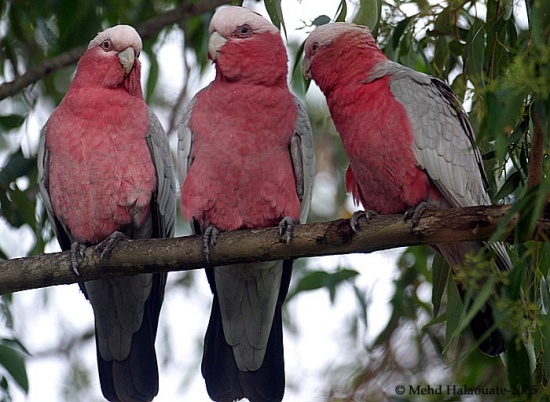Alternative Names: Rose-breasted Cockatoo, particularly in aviculture
- Eolophus roseicapilla
Cacatua roseicapilla
Identification
35–36 cm (13¾-14¼ in)
An unmistakable cockatoo with a rose pink head, breast and underparts, and a grey back, wings and tail. The short crest is white to pink depending on subspecies.
The sexes are similar, however can be distinguished on eye colour, or eye colour and eye ring (depending on the subspecies). Females have a red iris/red iris and red eye ring, while males have a grey eye ring and dark brown iris.
Distribution
The species is widespread over Australia, to which it is endemic. It is absent only from the most arid zones of the continent, and the far north of Cape York. Their distribution appears to have greatly expanded since European settlement, as it has benefited from the planting of crops and the provision of stock watering points in dry areas.
Taxonomy
It has historically been placed in genus Cacatua.
Subspecies
Earlier works incorrectly attributed eastern birds to the nominate race with the matter only recently resolved by Schodde et al. (2016)[5]. Three subspecies are recognized[1]:
- E. r. kuhli:
- Northern Australia (Northern Territory)
- E. r. roseicapilla:
- Western and west-central Australia
- E. r. albiceps: East-central and eastern Australia south to Tasmania
Habitat
Open woodland, riverine woodland, agricultural districts and human settlements.
Behaviour
Actions
Flocks typically twist and turn with powerful wingbeats showing alternate pink and gray.
Diet
They usually forage on the ground, eating seeds and rhizomes of pasture grasses and herbs. Also cereal grains, sunflower and sorghum seed. When nesting they prefer green seeding Erodium. Occasionally forage in trees.
Breeding
Monogamous with pairs remaining together year-round. They nest in tree cavities, laying clutches of 2-8 white eggs. Large clutches may be the result of two females laying in the same nest. Both parents incubate the eggs and raise the chicks.
Vocalisation
A distinctive high pitched call described as “chill chill” is given in flight.
Movements
Breeding birds mostly resident, but some birds form large nomadic flocks. Some seasonal movement away from arid areas during seasonal rain.
References
- Clements, J. F., T. S. Schulenberg, M. J. Iliff, S. M. Billerman, T. A. Fredericks, B. L. Sullivan, and C. L. Wood. 2019. The eBird/Clements Checklist of Birds of the World: v2019. Downloaded from http://www.birds.cornell.edu/clementschecklist/download/
- Higgins, P.J. (ed.) 1999. Handbook of Australian, New Zealand and Antarctic birds. Vol. 4, parrots to dollarbirds. Oxford University Press, Melbourne.
- Juniper, T. & Parr, M. (1998) Parrots: A Guide to Parrots of the World. Yale Univ. Press, New Haven and London.
- Rowley, I. & Boesman, P. (2019). Galah (Eolophus roseicapilla). In: del Hoyo, J., Elliott, A., Sargatal, J., Christie, D.A. & de Juana, E. (eds.). Handbook of the Birds of the World Alive. Lynx Edicions, Barcelona. (retrieved from https://www.hbw.com/node/54414 on 29 December 2019).
- Schodde, R., Black, A. B., and Fornasiero, J. (2016). East or west: to which subspecies does the type specimen of the Galah, Eolophus roseicapilla (Vieillot, 1817) (Aves: Cacatuidae), belong? Zootaxa 4067, 489–493.
- Styche, A. 2013. Galah. In Miskelly, C.M. (ed.) New Zealand Birds Online. www.nzbirdsonline.org.nz
Recommended Citation
- BirdForum Opus contributors. (2025) Galah. In: BirdForum, the forum for wild birds and birding. Retrieved 29 April 2025 from https://www.birdforum.net/opus/Galah
External Links
GSearch checked for 2020 platform.1






